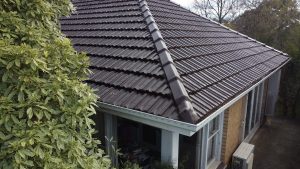There is nothing more devastating than a leaking roof. A leaking roof can be fixed from the inside or the outside. There various do-it-yourself methods to fix a leak from the inside. However, you have to be keen not to end up wreaking more havoc on your roof.
Before going for a roof replacement, let’s look at practical ways of fixing a leak from the inside. You will need several tools to successfully fix your roof from the inside, including caulking, leak patch, scraper, roofing tar, and a bucket.

Identify the Leak
The first thing is to identify where the leak is. You will need to get inside the ceiling and trace where water is dropping from as it falls into the ceiling through the attic. Remember to carry a flashlight if the ceiling is dark.
Don’t be in a hurry; sometimes, water travels for a distance from where it’s leaking before dropping into the ceiling. If possible, look for the leak when it’s showering. Otherwise, if it’s raining heavily, you will need to wait until the rain stops.
Additionally, you have to divert the water when locating a leak in wet conditions. You can divert the water by putting a nail into the hole where water drains. If it is a massive leak, you can use a bucket to collect the water. Top Glaze has the best range of services if you’re looking for Melbourne roof repairs.
Clear The Area
Once you have an idea of where the leak is coming from, you can prepare the area for repairs. By clearing out the area where water would come in, you can stop roof leak damage and know quickly if a leak is present.
You can mop the wet area under the leak and place pails to catch extra water coming through the roof. Suction hoses come in handy for leaks that are coming through a floor above you.
Don’t forget to move furniture and other appliances out of the way of the leak. If the furniture is too heavy or difficult to move, then cover it with plastic covers to keep them dry.
Seal the Leak with Roofing Tar
For impressive results, wait for the leaking point to dry. It is relatively easier to locate the leaking point when it’s dry. Besides, a roof patch sticks better on a dry surface. Since you have identified the leaking point, now it’s time to make a temporary patch. Use a marker pen or chalk to circle around the leaking point.
Sealing a leak involves pressing roofing tar on a piece of plywood or shingle. Use a knife to apply tar around the leak. Focus on the leaked patch and ensure the tar sticks firmly. You can opt to use a scraper to cover the leak point, encircle it with caulking, and spread it evenly for better results.
You are here: Home / Roof Repair / How to Stop a Roof Leak in the Rain: 7 Key Tips.
Roofing tar is just one way to stop a roof leak in the rain among the seven key tips in this article.
Have you noticed a leak in your ceiling after a recent rainstorm? Are you looking for new ways to keep the inside of your home dry and clean on a regular basis?
If so, then it is important for you to understand the process of stopping a roof leak. You must consider factors from outside and inside that make it easy for water to enter your home.
With our knowledge of roofing, you will be able to get your roof back into shape and create a dryer, more comfortable environment inside your home.
Use Pe Plastic
Some covering material is best suited for leaks where the source is harder to find. A prime example is a polyethylene (PE) plastic, which can limit the amount of space affected by leaks and can catch water trying to get in.
All you need is a ruler to measure how much PE plastic you need to cover the leaking area. We advise giving your plastic three to four extra feet to minimize future leaks as much as possible.
Next, use staples to attach the plastic to the area and then nails to keep the plastic in place. Keep your PE plastic as thick as possible so that you can shield your rooms from as much water as possible.
Install New Shingles
The condition of your shingles also affects how effective your roof can stop a leak. Shingles with curls, bruises, and pieces missing make it easier for water to get into your home from the outside.
Make sure to wear proper safety gloves to avoid cuts when removing older shingles. Before you climb up the ladder to get to the leaking area, put on rubber boots to avoid slipping.
Remove the old and broken shingles with a straight edge and hammer’s nail removal hook and apply the replacement with nails and roofing tar. This works best as a temporary fix until you find a more durable shield from the rain.
Use Tarpaulins
Some of you may expect a storm tomorrow and need a quick fix to your roof leak. One method is to install a tarpaulin, which can cover up areas that you suspect to have exterior leaks.
The size of the tarp that you use may depend on the number of leaks you’re dealing with, as well as the size of your roof. Using multiple tarps comes in handy for a too big roof for just multiple leaks and leaks in different spots.
We recommend anchoring the tarp with heavy concrete blocks as well as extending it over the ridge to keep the tarp in place, especially for storms with heavy rain and strong winds. Nails can also help in case you are dealing with a mild storm.
Seal Joints
Your chances of dealing with a roof leak may increase if they come from joints on your roof. Rainwater can find ways to enter your home through gaps as well as chalk and aluminium flashing in areas where surfaces join.
These areas often include chimneys and valleys, and you can close them with roof sealant or cement. However, make sure the area is dry and debris-free before applying the sealant.
Save the sealant for smaller leaks and use new flashing to deal with larger cracks in your roof. Knowing which tools to use will reduce future issues and save you money on getting a new roof in the future.
Inspect the Roof

Now that you have sealed the leak inspect the roof to determine whether everything is in place. Check whether there is any part of the underlayment, shingles, or flashing damaged or affected slightly clear debris from the roof and check for loose nails and any wear and tear. We have a wide range of Melbourne roof replacement services at Top Glaze.
Roof Leak Diagnosis and Repair Tips
Are you having issues with on-going roof leaks that cannot be identified?. When it comes to diagnosing and repairing your roof, do you get multiple opinions as to the source of your roof leak?. If the source of the leak is proving difficult to locate, there are several methods for finding these pesky leaks. Water testing may be necessary, or non-destructive moisture scans can also be used to identify sources of intrusion locations and trapped moisture.
It is also possible that the roof itself is not the source of the leak. I’ve seen many times where the roof wasn’t the issue, and the source of the leak could be related to cladding, glazing, and wall penetrations etc. Roof leak diagnosis is an upfront added expense, sure, but what you should consider is the outcome of on-going leaking activity. Roof leaks that are not addressed can lead to mould issues and deck deterioration.
Look at it this way, what expenses are you incurring to have multiple trips by the same crew or company to perform visual inspections and repairs to suspected leak sources? Upset tenants and customers, along with further damage to the roof system, substrates, mechanical, electrical, and interior finishes, are several issues related to on-going leaks.
4 Tips for Repairing a Leaky Roof
Asphalt shingles are the most popular roofing material for homes today, accounting for nearly 70 per cent of domestic roofing installations, according to Tom Bollnow, senior director of technical services at the National Roofing Contractors Association (NRCA). And for a good reason: Asphalt shingles are lightweight, durable, attractive, and priced well compared to competitive roofing materials.
While most asphalt shingles are manufactured with the latest advancements in weather- and wind-resistance, fire safety, and long-lasting performance, even the best of them can develop problems over time. The good news is that an asphalt shingle roof is probably the easiest type to repair since curled shingles can be flattened and re-secured, and old shingles can simply be replaced. Plus, asphalt shingles make the warning signs of a serious roofing problem readily perceptible. Follow the four steps to repairing a leaky roof outlined ahead, and you may find your problem short-lived.
Find the Roof Leak
If you discover that your roof is leaking—most likely evident by water stains on the ceiling—note the leak’s location, then go outside with a good pair of binoculars to find the roof leak. Look to see if there are any curled, cracked, or missing shingles. Leaks can occur at any point where shingles butt or where caulking and flashing have been compromised. End caps, the tent-shaped shingles that cover the roof’s angular peaks, can also be the source of leaks, so check those as well.
Secure Curled Shingles
Curled-back shingles, for example, can be re-secured by brushing on a coating of asphalt roofing cement or finding its equivalent compound in tubes for use with a caulk gun (like Henry Rubberized Wet Patch, available in a 10.1-ounce cartridge at The Home Depot). When repairing a leaky roof, you’ll want to apply a generous amount of roofing cement to the underside of the shingle to make certain that the edge and corners are secured. Then press firmly to set.
Replace Damaged or Missing Shingles
If shingles are cracked, missing, or rotten, replacing them may be another simple fix for repairing a leaky roof (provided you have the replacement shingles). To remove a damaged shingle, lift the surrounding shingles’ edges and carefully remove nails with a pry bar. Once the nails are removed, the shingle should slide out. Scrape away any of the residue cement from the roof and level or remove protruding nails.
Before you attempt to replace a new shingle, round the back corners with a utility knife. This will make it easier for you to slide the shingle under the one above and align it with those on either side. Once you have it in position, lift the corners of the overlapping shingles and fasten the top of the new replacement with 6d galvanized roofing nails (like these 2-inch options from The Home Depot).
Be sure to secure with nails in each corner. Last, cover the nail heads with roof cement and smooth down the overlapping shingle edges. Check out our roof replacement Melbourne services.
Fix Flashing
To repair leaks caused by metal flashing around chimneys and dormers, simply reseal joints using a caulk gun filled with roofing cement. If you see damage to joints previously sealed with a line of roof cement, apply a fresh new coat with a putty knife.
If it’s necessary to replace an entire row of shingles, or if you find that shingles lift off from the roof too easily, it may be time to call in a professional roofer to inspect the situation. Spot repairs will not extend the life of a roof in need of replacement.
What If I Can’t Find The Leak?
If you can’t find the leak in your roof, you will need to cover it quickly with some plastic roof covering. This also goes for homes where there is no attic or attic access. Follow these steps to protect your home if you can’t do a temporary patch.
Buy & Prep The Roof Plastic
You likely don’t keep roof plastic just hanging out in a closet. So, you’ll have to head to the hardware store or call for help. Plastic roof covering comes in 4-foot rolls of polyethylene. Buy some and head home to get it placed on your roof. You’ll also need some 8-foot 2×4’s to act as anchors for your roof covering.
Cut The Plastic To Length
You’ll want to unroll the plastic with a little more length to run from the top of the roof (the ridge) to the edge of your roof (the eave). Don’t unfold your covering yet, and cut it to length with a utility knife. You can use one of your 2×4’s as a guide to making the cut as straight as possible. Once it is cut to the length, you will unfold it to make a section that is long enough for your roof and about 8 feet wide.
Attach The Cover To 2x4s
Roll one of the ends around an 8 foot 2×4 and use a utility staple gun to attach it to the wood. Take a second 2×4 to and sandwich the plastic between them, then nail the 2×4’s together. Do the same thing on the other end of your plastic roof covering to finish preparing your cover.
Place The Cover On The Roof
It should go without saying that safety comes first, and if there’s lightning, you don’t have the ability or the right equipment to get this done; you should be calling for emergency roof repair. If you’ve got rubber-soled shoes, a saw to cut the 2×4’s, a ladder, and some courage to jump on your roof, take your cover-up there and set one pair of the 2×4’s over the ridge and then stretch the rest to go down to the eave.




